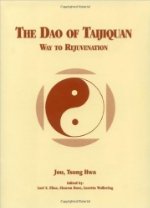The Dao of Taijiquan: Way to Rejuvenation by Jou, Tsung Hwa
This book is used as a textbook in our classes. Master Jou is referred to often and his book is very informative. We consider it required reading for any serious taijiquan practitioner!
https://a.co/d/9b1FxZ4 - order on Amazon
Drawing Silk: Master's Secrets for Successful Tai Chi Practice
by Paul B. Gallagher
Available through Amazon:
Taijiquan Classics: a Comparative Guide
Almanzo “LaoMa” Lamoureux, ed
A compilation of eight different well-know translations of the Zhang Sanfeng Classic for comparison and study. In addition, we present the translations of the Zhang Sanfeng, Wang Zongyue, and Wu Yuxiang writings are taken from Jou Tsung Hwa's The Dao of Taijiquan: Way to Rejuvenation with characters, pinyin romanization, and tone marks. More than just a study guide, the “Classics” is a research and reference tool for Taijiquan students who want to use Chinese-English dictionaries to decipher and translate Chinese characters on their own.
"This is a compilation of the three major Taijiquan Classics is the joint-effort of my senior students, Richard Kovarik, Zhao Jinxiu, Cheryl Lynn, and Selden Lamoureux. It includes the works of Zhang Sanfeng, Wang Zongyue, and Wu Yuxiang, and an accompanying comparison of eight Taijiquan Lun translations. It is designed as a compact reference workbook to encourage and assist the more serious and dedicated taijiquan student to consult the Taijiquan Classics. In addition, and more importantly to me, it gives access to a Chinese dictionary in self-search of a deeper, more illuminating understanding of the principles and practices underlining the foundation of our art, as expressed in the original Chinese of these seminal writings".....LaoMa
For a preview of this booklet, click here.
Price: $12
Glossary of Chinese Terms, Names and Phrases
Almanzo “LaoMa” Lamoureux, ed
A unique reference work with a short history of romanization systems, a bibliography of 19 sources, and the characters, pinyin, and tones for over 640 Chinese names and terms related to the study of Taijiquan, arranged by category. An invaluable aid for students interested in deepening their understanding of Chinese language and culture.
This glossary contains 94 pages of terms, with Chinese characters, pinyin and often Wade-Giles romanizations, plus tones and definitions and a newly introduced index. It is the most extensive glossary of terms useful to taiji students that we know of. The table of contents is presented here. Click here to view sample pages.
Chinese terms are in the pinyin romanization. Terms in brackets, [ ], are in the Wade-Giles romanization, or in the romanization most often seen in literature. The names of notable Chinese persons are in the romanization most commonly seen in literature.
A limitation in the computer program that was used to create this document prevents the displaying of a tone mark on an uppercase letter. In those cases where this occurs in this document, we have used a lowercase letter with the proper tone mark, even though it may make the word or phrase appear unusual. In addition, the Chinese characters for the Taijiquan techniques lu and lie are specific to Taijiquan and are not generally available in computer fonts. In this document, we have substituted those characters most often used by Chinese Taijiquan players when they refer to these techniques in computer-generated documents.
This glossary is a living document. The authors welcome suggestions and additions. Readers may contact LaoMa with comments regarding this glossary.
Price: $15



